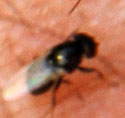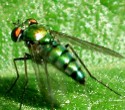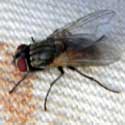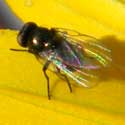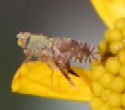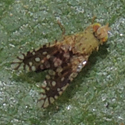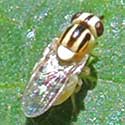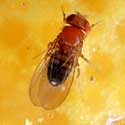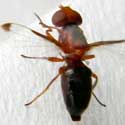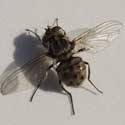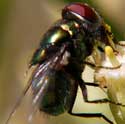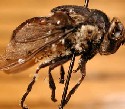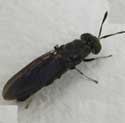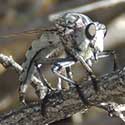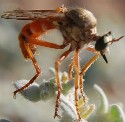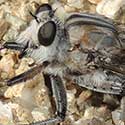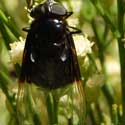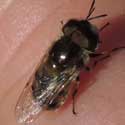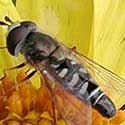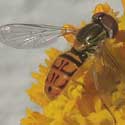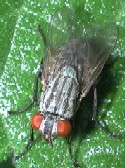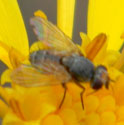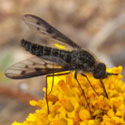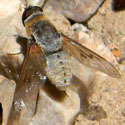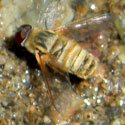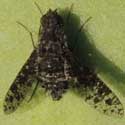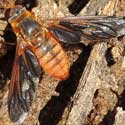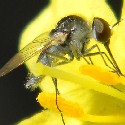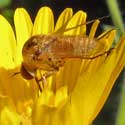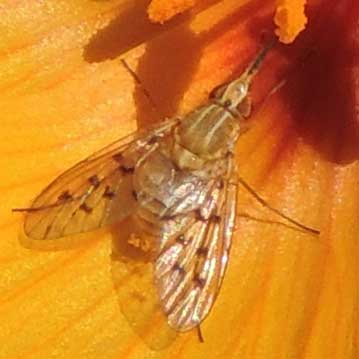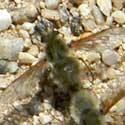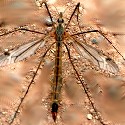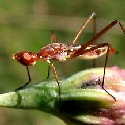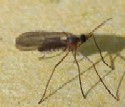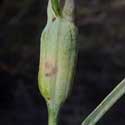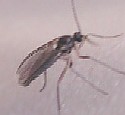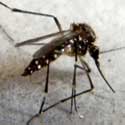One pair of wings (other flying insect groups have two pairs). In place of
second pair of wings are a pair of halteres - a knobbed end rod - used to maintain balanced
flight. Mouth parts are modified for lapping or piercing sucking. Astounding number of species.
Just a pathetic few in guide so far ...
Eye Gnat
Hippelates
Very small shiny black or yellow flies that get into eyes of hikers and
range cattle. Common esp. late spring. More info
...
|
Long-Legged Fly
Condylostylus sp.
Iridescent, small, green-blue flies that seem to dance upon sunny leaf
surfaces. Common near moist environments. More info
...
|
House Fly
Musca domestica
Abundant fly around farm operations and human habitations.
Sponging-lapping mouthparts. More info
...
|
Leaf Miner Fly
Agromyzidae
Minute black or black and yellowish flies that mine inside leaves or else
in developing seeds. More info
...
|
Fruit Fly
Euaresta sp.
Small flies with patterned wings often seen flitting about on flower heads
going to seed. More info
...
|
Ambrosia Seed Maggot
Euaresta stigmatica
The larvae (maggots) feed in the flower heads of ragweeds and bursage (Ambrosia spp.). More info
...
|
Chloropid Fly
Thaumatomyia sp.
A small fly when examined closely is colorful and fascinating. More info
...
|
Vinegar Fly
Drosophila melanogaster
The familiar fruit fly of kitchens and biology labs. Uses fermenting fruits as larval food. More info
...
|
Signal Fly
Senopterina sp.
Small flies with marked wings that are fluttered as the insect runs about.
More
info ...
|
Stable Fly
Stomoxys calcitrans
The larva breeds in moist, decaying plant matter. The adults bite to get a blood meal. More info
...
|
Green Bottle Fly
Lucilia sp.
Iridescent green flies common around flowers, feces, and carrion.
Attracted also to meat as say at a BBQ. Larvae in decomposing flesh. More info
...
|
Bot Fly
Cuterebra sp.
Very large, mostly black flies most often seen at hilltops. Harmless as
adults. Larvae parasitic within mammals. More info
...
|
Soldier Fly
Hermetia illucens
Large, jet-black fly, rather clumsy in flight. Attracted to moist,
decomposing plant material. More info
...
|
Robber Fly
Efferia
Active flies that alight on prominent points and sally out to catch
smaller insects on the wing. Legs with stout tarsal claws at feet. Many kinds in the
Sonoran Desert. More info
...
|
Robber Fly
Efferia
The larger version is mostly white and dark gray. Seen along desert washes. More info
...
|
Robber Fly
Saropogon mohawki
Active flies that alight on prominent points and sally out to catch
smaller insects on the wing. Legs with stout tarsal claws at feet. More info
...
|
Giant Robber Fly
Promachus
Large predatory fly that gives chase to and catches other insects on the wing. More info
...
|
Cactus Fly
Copestylum mexicanum
Large, shiny black fly with two-toned wings. Visits flowers for nectar in
late summer and fall. Larva stage develops inside rotting cactus. More
info ...
|
Hover Fly
Copestylum
These harmless flies resemble honey bees. More info
...
|
Hover Fly
Eupeodes volucris
These flies are common on composite flowers and look like small bees. More info
...
|
Hover Fly
Toxomerus
Small, delicate, brightly colored fly that is often seen visiting flowers. More info
...
|
Tachinid Fly
Tachinidae
Ordinary-looking flies that visit flowers or alight on vegetation.
Parasitic as larvae in caterpillars and other insects. More info
...
|
Small Tachinid
Siphona sp.
A diminutive tachinid that was on the wing in December. Extended proboscis
for taking flower nectar. More info
...
|
Bee Fly
Many kinds of flies visit flowers for nectar and are important pollinators. More info
...
|
Bee-Fly
Paravilla cinerea
Bee-flies are active during sunny weather; they hover and land on the soil
or else pay visit to flowers. Wings often with markings. Many, many kinds in Sonoran
Desert, More info
...
|
Bee-Fly
Villa sp.
Hovers close to ground and alights often in sunny spot, sometimes on moist
soil. More
info ...
|
Black Speckled Bee-fly
Anthrax sp.
The carbon-black wing spots and body make it conspicuous. Hovers near ground. Harmless to people. More info
...
|
Very Large Bee-Fly
Poecilanthrax
These robust flies rest in the sunshine sitting often close to the ground. May be beneficial to farmers. More info
...
|
Very Small Bee-Fly
Geron sp.
Very small hovering fly partial to flowers. Long mouthparts for taking
nectar. More info
...
|
Very Small Bee-Fly
Geron sp. #2
Another Geron species, this one's humped back is covered with gold-flecked setae (hairs). More info
...
|
Small Bee-Fly
Poecilognathus spp.
Moisture and probably some additional nutrients draw these small flower loving flies to probe the anthers of flowers. More info
...
|
Paired Bee-flies
Anastoechus sp.
A long slender proboscis for sipping nectar and hairy body. Sometimes two
are joined. More info
...
|
Crane Fly
Tipula spp.
Large slow-flying insects look like a giant mosquito with very long legs.
Common to abundant in spring in the desert. More info
...
|
Stilt-legged Fly
Micropezidae
Small, delicate flies found in display on vegetation near damp spots. Look
in Sonoran Desert riparian habitats. More info
...
|
Gall Midge
Asphondylia spp.
Minute, mosquito-like flies as adults. As larvae they live inside plant
tissues and cause formation of various gall structures. Many kinds on a wide variety of
plants. More info
...
|
Odora Gall Midge
Asphondylia sp.
On freshly growing stems of Odora swellings are cause by feeding
larvae of a small midge fly. More
info ...
|
Dark-winged Fungus Gnat
Sciaridae
Minute gnats that frequent areas of damp soil including potted plants,
compost and margins of riparian streams. More info
...
|
Yellow Fever Mosquito
Aedes aegypti
Small, aggressive, blood sucker that is often abundant in Sonoran Desert
cities. Bites ankles especially. Black with white spots. More info
...
|
